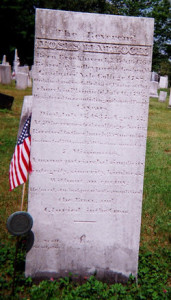Reverend Moses Hallock – 1760 – 1837

Reverend Moses Hallock’s Grave Marker
Soon after he settled in Plainfield in 1792 the Rev. Hallock found that his salary was inadequate so he “began to receive students into his family” and started his preaching andteaching that continued for more than 30 years. For a dollar a week the person rec’d board and tuition. This source says that Hallock taught over 300 students of whom 132 entered college and 50 became ministers and six becoming missionaries.
In 1815 two of his sons were attending Williams as evidenced by a letter that is in the archives. From: Williams College and Foreign Missions by John H. Hewitt c1914
- The Godly Pastor: Life of the Rev. Jeremiah Hallock of Canton, Connecticut to which is added a sketch of the life of the Rev. Moses Hallock of Plainfield Massachusetts by Cyrus Yale
- Find a Grave – Rev. Moses Hallock
The Missionary Movement
Mission Park – A ten-acre park commemorating the “Birthplace of American Foreign Missions.” Mission Park and the Haystack Monument are located a short walk north of the First Congregational Church and Chapin Hall, on the Williams College campus.
The Hallock Family
HALLOCK, William Allen, editor, was born in Plainfield, Mass., June 2, 1794; son of the Rev. Moses Halleck, educator (born 1760, died 1887), a graduate of Yale, 1788; a soldier in the war of the American Revolution; pastor of the church at Plainfield, and conductor of a celebrated school where William Cullen Bryant and John Brown the abolitionist were pupils. His uncle, the Rev. Jeremiah Halleck (1758-1826) was pastor of the Congregational church at West Simsbury, Mass., 1785-1826, and received the degree of A.M. from Yale in 1788. William Allen was graduated at Williams, A.B., 1819, A.M., 1822, and at Andover theological seminary in 1822. He was agent of the New England tract society, 1822-25, and corresponding secretary of the American tract society, 1825-70. He was responsible for every book, tract and paper published by the society, as every manuscript passed through his hands and was accepted by him before printed. He was editor of The American Messenger, 1830-70, and of The Child’s Paper, 1845-70. He received the degree of D.D. from Rutgers [p.44] in 1850. In 1868 he married as his second wife, Mrs. Mary Angeline Lathrop, author of That Sweet Story of Old (1856); Bethlehem and Her Children (1858); Life of the Apostle Paul (1860); Life of Solomon (1868); Fall of Jerusalem (1869); Life of Daniel (1870); and Beasts and Birds (1870). He wrote Life of Harlan Page (1835); Life of the Rev. Moses Hallock (1854); and Life of the Rev. Justin Edwards (1855); besides innumerable tracts. Mrs. H. C. Knight prepared Memorial of the Rev. William A. Hallock, D.D. (1882). He died in New York city, Oct. 2, 1880. The Twentieth Century Biographical Dictionary of Notable Americans: Volume V, page 44
“HALLOCK, Gerard, journalist, was born in Plainfield, Mass., March 18, 1800; son of the Rev. Moses Halleck. He was graduated at Williams, A.B., 1819, A.M., 1822, and in 1824 established in Boston the Telegraph, which in 1825 was merged into the Recorder. He removed to New York city in 1827, to assist in editing the New York Observer, of which he was part owner, and in 1828 became part owner with David Hale in the Journal of Commerce. In 1828 they obtained advance European news by intercepting incoming vessels at Sandy Hook, and in 1833 secured advance information from congress by an express coach between Philadelphia and New York, with eight relays of horses, and this relay was subsequently extended to Washington and finally resulted in the Halifax express. Although a pro-slavery Democrat, he was a friend of the slaves, believing in emancipation through compensation to owners, and he personally purchased the freedom of upwards of one hundred slaves, whom he transported to Liberia. He contributed $119,000 to erect and maintain a church in New Haven, Conn., and founded the Southern Aid society when the American home mission society withdrew its support from the churches maintained by slave-holders. When the government in 1861 denied the use of the mails to the Journal of Commerce, Mr. Halleck retired from journalism and from all participation in public affairs. He died in New Haven, Conn., Jan. 4, 1866.” The Twentieth Century Biographical Dictionary of Notable Americans: Volume V
Why our Flag Flies Over Oregon by Leavitt Homan Hallock – Library of Congress Homan Hallock – 1803 – 1894
Find a Grave – Homan Hallock
In 1864, the punchcutter Homan Hallock, who with Eli Smith was responsible for the admirable ‘American Arabic’ types that were used in the Van Dyck Bible translation, produced this experimental Arabic type. It may be the first attempt at systematic Arabic script reform, preceding the Cairo Academy initiative of 1933 by almost seventy years. It doesn’t seem to have been employed, except in the single specimen sheet produced by Hallock.
Some observations on printing Arabic in America and by Americans abroad by Miroslav Krek
